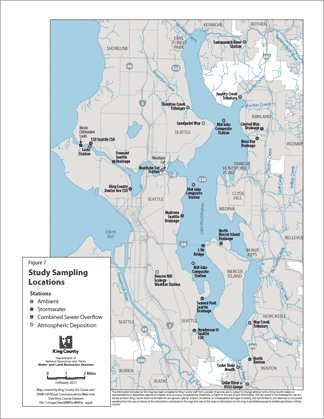Estimating toxics loadings to the Lake Washington Watershed

Background
Fish can become contaminated with a class of chemicals called polychlorinated biphenyls (PCBs). Commercial products and industry used PCBs widely until they were banned in 1977. Despite bans, PCBs remain at toxic levels in the environment and especially in fish. Contaminated fish can pose a health risk to the people who eat them. Lake Washington is the largest freshwater lake in King County, Washington and fish in the lake have some of the highest concentrations of PCBs measured across the state. No one knows exactly where PCBs in Lake Washington fishes originate.
- The goal of this project was to help answer the following questions.
- What input pathways contribute PCBs to Lake Washington?
- Do we need to reduce the ongoing sources of PCBs entering the lake?
- Are fish accumulating PCBs only from historical pollution present in lake sediments?
- To what extent do PCBs exit the Ship Canal and contaminate Puget Sound?
Please refer to the EPA's PCB website for background information on PCBs.
Project objectives
This project developed numeric tools to understand how to reduce contaminant concentrations in Lake Washington fish. This project examined PCBs and polybrominated diphenyl ethers (PBDEs). The tools estimated how much each contaminant comes into Lake Washington and Elliott Bay and identified their routes or pathways. The results are helping water quality managers identify how to reach safe PCB and PBDE levels in fish.
The pathways we estimated include:
- combined sewer overflows (CSOs)
- stormwater discharges
- road runoff
- river input
- air deposition
The project's tools consist of:
- Annual loadings of PCBs and PBDEs. We estimated these loadings from existing and new data collected by this project.
- Fate and transport and bioaccumulation models. These models enabled us to test different PCB reduction scenarios.
Project components

Sampling locations map
Field study
The field study collected data to estimate PCB and PBDE loadings (total mass per year). We focused on loadings entering Lake Washington and Elliott Bay (via the Ship Canal). We collected data in 2012-2013. These data included:
- Total organic carbon
- PCB and PBDE congener concentrations
- Associated flow rates for each pathway
- Tributaries
- Atmospheric deposition
- Stormwater runoff
- CSO discharge
- Road runoff
A map of the sampling locations is available for viewing.
Model development
We estimated the loadings for each pathway and the total for Lake Washington and Elliott Bay. We used historical and the new data for this estimation. We also developed a fate and transport model and a bioaccumulation model. We then simulated how fish tissues respond to different PCB reduction scenarios. Too little PBDE data were available for fish tissue and sediment. As a result, we did not simulate fish tissue response for PBDE reduction scenarios.
PCB reduction options
The project team and advisory panel selected a variety of PCB reduction scenarios. To select the scenarios, we used information on relative pathway contributions. Scenarios differed by the total reduction in PCB load. We then modelled the scenario outcomes by running various simulations. The results informed which reductions are the most important to pursue. Successful reductions will help reduce fish tissue concentrations until they are safe for human consumption.
Management Discussion
The results of this project identified the key PCB pathways needing reduction. Water quality managers and stakeholders can use these results to inform policy decisions. Successful reductions can help us reach safe levels in Lake Washington fish tissue. We shared the results with technical and policy groups and post the final report on this website.
Advisory panel
We formed a project advisory panel. The panel's role was to provide input and guidance to the project team over the whole project period. We invited representatives from community groups and different levels of government to join. Panel members shared the goal of reducing PCB bioaccumulation in Lake Washington fish.
- Fred Bergdolt, Washington State Department of Transportation
- Betsy Cooper, King County, Wastewater Treatment Division
- Jonathan Frodge, City of Seattle
- Jenny Gaus, City of Kirkland
- Joan Hardy, Washington State Department of Health
- Rachel McCrea, Washington State Department of Ecology
- Doug Navetski, King County, Surface Water Management
- Andy Rheaume, City of Redmond
- Ron Straka, City of Renton
- Bruce Tiffany, King County, Wastewater Treatment Division
- Heather Trim, People for Puget Sound
- Patrick Yamashita, City of Mercer Island
Project status
This project was completed on March 30, 2014. Please see the Final Report (link below) for a summary of project findings.
Project products
- Field Study and Quality Assurance Project Plan (7.4 Mb Adobe Acrobat)
- Field Study Data Report (5.2 Mb Adobe Acrobat)
- Field Study Data Report Addenda
- Sediment Data Addendum (1.28 Mb Adobe Acrobat)
- Tissue Data Addendum (1.06 Mb Adobe Acrobat)
- PCB/PBDE Loading Estimates for the Greater Lake Washington Watershed (4.3 Mb Adobe Acrobat)
- Errata (73 Kb Adobe Acrobat)
- Modeling Quality Assurance Project Plan (389 Kb Adobe Acrobat)
- PCB Fate and Bioaccumulation Modeling Report (2.3 Mb Adobe Acrobat)
- Appendix C: Bioaccumulation Model Sensitivity Analysis Results (184 Kb Adobe Acrobat)
- Final Report (670 Kb Adobe Acrobat)
- Final Report Erratum (70 Kb Adobe Acrobat)
King County project team
- Jenée Colton: Grant Project Manager and Bioaccumulation Modeler
- Richard Jack: Technical Support and QA Officer
- Curtis DeGasperi: Modeler
- Deborah Lester: Document Review
- Sally Abella: Lakes Water Quality advisor
- Colin Elliott: King County Environmental Lab Project Manager

 Translate
Translate